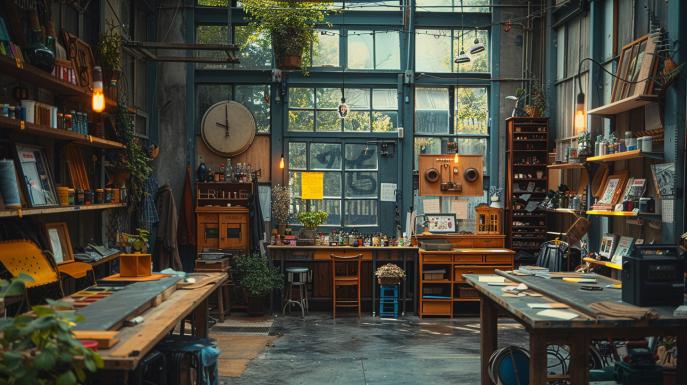Imagine transforming those forgotten jeans or that worn-out chair into exclusive pieces that carry style and personality. Does it seem like magic? No, it's upcycling! With “Upcycling: see how to renew old items”, you will be guided through a universe where the old becomes sensationally new. Discover how to start your upcycling project at home, master techniques for beginners and see old furniture get a new look. Join us on this creative journey where every object has a brilliant second chance to delight!
How to start your upcycling project at home?
To get started with upcycling, identify unused items that can be transformed. Basic tools such as screwdrivers, hammer, scissors and materials such as glue and paint are useful. Effective planning involves defining the ultimate goal of the item and considering its functionality to ensure success.
What are the best upcycling techniques for beginners?
For those just starting out, some of the best upcycling techniques include painting and decorating objects, reusing fabrics and transforming pallets into furniture. Upcycling projects from scratch can be as simple as decorating old cans to serve as plant pots or as complex as converting an old ladder into a stylish bookshelf. Upcycling workshops are valuable resources for learning more, as they offer practical guidance and inspire new ideas. Find one local community or online workshops can further expand your repertoire and connections.
How to transform old furniture into unique and modern pieces?
Furniture upcycling revitalizes old pieces, using creativity to transform them. It starts with a clear renovation process: disassembly, cleaning, sanding and painting or varnishing. Creative ideas range from reupholstering to adding unexpected decorative elements or revamping with decoupage, engravings and stenciling. These restoration and reuse techniques give any piece a contemporary charm. Surprises await in the gallery of examples of upcycling transformations, where the old becomes new, demonstrating the power of unique upcycled pieces.
What materials can I use and how do I prepare them for upcycling?
What are the ideal materials for upcycling and how to prepare them? Durable materials like metal, wood and fabric are great choices. First, identify objects that are no longer in use but that have the capacity to be transformed. Then make a critical selection, prioritizing items that can be easily cleaned or repaired. Preparation for reusing materials includes deep cleaning, minor repairs or disassembly. Furthermore, it is important to think about storing recyclable materials for upcycling, keeping them in good condition until the moment of transformation. Creative recycling demands both inspiration and organized space to house the potential of each piece.
How can sustainable fashion benefit from upcycling?
Sustainable fashion and upcycling are natural allies. Clothing customization is an aspect of upcycling in fashion, enabling the transformation of unused pieces into valuable and stylish items. While traditional fashion contributes to the accumulation of waste and pollution, upcycling inserts creativity into the process, reallocating what would otherwise be discarded into the use cycle. Successful brands have incorporated this practice, reducing environmental impacts and revaluing what already exists.
What is the environmental impact of upcycling and how does it contribute to the circular economy?
Upcycling reduces waste, reuses materials, and preserves natural resources, reducing landfill pollution. This process is essential for a circular economy, where products remain in use for longer. Creativity is key when transforming discarded items into new treasures, mitigating environmental impact and encouraging sustainable innovation.
On this journey through the world of upcycling, we explore everything from the basics of starting a project at home to innovative practices in the field of sustainable fashion. Armed with an understanding of the necessary tools, basic techniques and the inspiration to transform old furniture, we now possess the vision to identify and prepare materials that would once have been discarded. This cycle of renewal not only fuels our creativity, but also strengthens the circular economy, minimizing environmental impact. Upcycling is more than a hobby; it is a link between sustainability and innovation, a tangible reflection of our ability to reinvent and preserve the world around us.
FAQ
- How can I start an upcycling project at home? To start an upcycling project at home, identify unused items that can be transformed. It's helpful to have basic tools like screwdrivers, a hammer, and scissors, and supplies like glue and paint. Prepare a plan to define the ultimate purpose of the item and consider its functionality.
- What upcycling techniques are recommended for beginners? For beginners, recommended techniques include painting, decorating objects, reusing fabrics and transforming pallets into furniture. Decorating old cans or converting old stairs into shelves are simple examples. Upcycling workshops can provide guidance and inspire new ideas, as can finding local communities or online workshops.
- How can I transform old furniture through upcycling? To transform old furniture, start by disassembling, cleaning, sanding and painting or varnishing. You can reupholster or add unexpected decorations, use decoupage, engravings or stencils to give it a contemporary touch. The gallery of upcycling examples can be a source of inspiration for your project.
- What types of materials are suitable for upcycling and what is the preparation process? Durable materials like metal, wood and fabric are ideal for upcycling. Select items that can be cleaned or repaired. Preparation involves deep cleaning, minor repairs or disassembly, and it is important to store materials in an organized manner to maintain their condition until the transformation process.
- How does sustainable fashion benefit from upcycling? Sustainable fashion benefits from upcycling by allowing the customization of clothing that transforms unused pieces into valuable and stylish items. It reduces waste, pollution and incorporates creativity into the use cycle, with successful brands adopting this practice to reduce environmental impacts and revalue existing resources.


